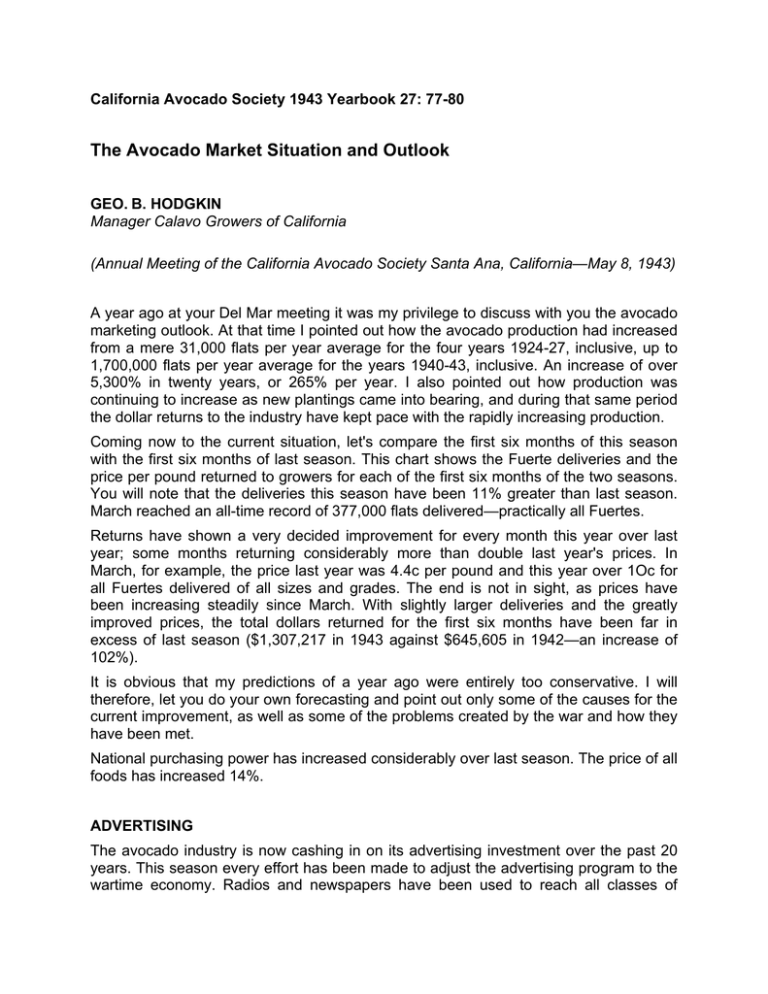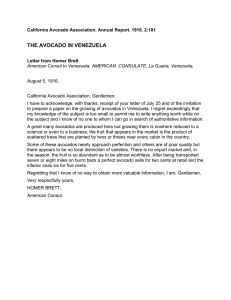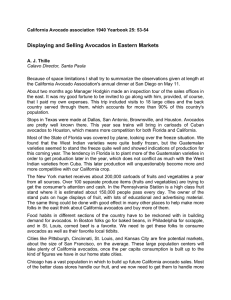The Avocado Market Situation and Outlook
advertisement

California Avocado Society 1943 Yearbook 27: 77-80 The Avocado Market Situation and Outlook GEO. B. HODGKIN Manager Calavo Growers of California (Annual Meeting of the California Avocado Society Santa Ana, California—May 8, 1943) A year ago at your Del Mar meeting it was my privilege to discuss with you the avocado marketing outlook. At that time I pointed out how the avocado production had increased from a mere 31,000 flats per year average for the four years 1924-27, inclusive, up to 1,700,000 flats per year average for the years 1940-43, inclusive. An increase of over 5,300% in twenty years, or 265% per year. I also pointed out how production was continuing to increase as new plantings came into bearing, and during that same period the dollar returns to the industry have kept pace with the rapidly increasing production. Coming now to the current situation, let's compare the first six months of this season with the first six months of last season. This chart shows the Fuerte deliveries and the price per pound returned to growers for each of the first six months of the two seasons. You will note that the deliveries this season have been 11% greater than last season. March reached an all-time record of 377,000 flats delivered—practically all Fuertes. Returns have shown a very decided improvement for every month this year over last year; some months returning considerably more than double last year's prices. In March, for example, the price last year was 4.4c per pound and this year over 1Oc for all Fuertes delivered of all sizes and grades. The end is not in sight, as prices have been increasing steadily since March. With slightly larger deliveries and the greatly improved prices, the total dollars returned for the first six months have been far in excess of last season ($1,307,217 in 1943 against $645,605 in 1942—an increase of 102%). It is obvious that my predictions of a year ago were entirely too conservative. I will therefore, let you do your own forecasting and point out only some of the causes for the current improvement, as well as some of the problems created by the war and how they have been met. National purchasing power has increased considerably over last season. The price of all foods has increased 14%. ADVERTISING The avocado industry is now cashing in on its advertising investment over the past 20 years. This season every effort has been made to adjust the advertising program to the wartime economy. Radios and newspapers have been used to reach all classes of buyers, especially the war workers with the fat pay envelopes. Our new type of advertising is best illustrated by the new consumer booklet entitled "How Calavo Answers Food Shortages and Rationing," calling attention to the fact that Calavos are plentiful and suggesting recipes for lunch-box sandwiches. Also, that Calavos are versatile—how they can be used as an alternate for meat or a butter-stretcher. Special emphasis is given to Calavo nutritional qualities—how they compare favorably with other commonly-used salad ingredients. Also, how they are a time-saver, and that they take so little effort for preparation; and finally, how they should be handled when they are ready to cut; how to store them and prepare the dishes. MILITARY SALES Greatest emphasis this season has been placed on sales to the military forces. Early experiences with the use of avocados in military camps indicated that it would be necessary to carry on active educational campaigns, if avocados were to give satisfaction and to be purchased in quantities. Too often the Mess Sergeants and Supply Officers had never seen nor heard of an avocado. Avocados were served firm, over-ripe or cooked, and many of them found their way to the garbage can. After obtaining permission from the military authorities, we prepared a "Military Portfolio" on avocados for the military chefs. We then trained a force of men and women to call on the Army camps; give lectures to the Cooks and Bakers Schools, and leave with the Supply Officers and Mess Sergeants charts and copies of the "Portfolios." After months of preparation, and repeated calls, I am glad to report that the armed forces are now using avocados in large quantities. During the past few weeks, we have sold over ten carloads to military camps. PRICE CEILINGS One of the most difficult problems confronting the industry has to do with price ceilings. The aim of price ceilings, of course, is to hold down the cost of living and prevent inflation. The objective is extremely worthwhile, but there are many who hold that the best way to prevent inflation is to siphon off surplus purchasing power by means of taxes, and stimulate the maximum production of goods through normal prices. It is not my purpose to discuss price ceilings in general, but only as they apply to avocados and other perishable fruits and vegetables. The problem of figuring out proper price ceilings for produce is tremendously complicated by the multiplicity of varieties, grades, sizes, seasonality and qualities of all the different perishable commodities. In the past, these price relationships had been adjusted by the law of supply and demand. If the price of potatoes, for example, was too low, the farmer might plant onions or beans. If the price of lettuce was high, he switched from carrots to lettuce. If the outlook for lemons looked bad, he might pull out his trees and plant avocados, or top-work to oranges. The dealers who handle these perishable commodities endeavored to sell their fresh, high-quality produce at a high price so as to average out with the low prices received for the poor quality and the left-overs. The deterioration in quality takes place daily, and in some products even hourly. A price ceiling based on average prices makes it impossible for the producer or dealer to secure more than the ceiling for his best and freshest produce, and he has no opportunity to average out with the old or poorer produce. In other words, a price ceiling is a top price—not an average or a guaranteed or a minimum price. There are many ways of getting around price ceilings, and unfortunately there are many people willing to try them. In the case of farm produce, there are so many farmers and so many dealers and peddlers that to police all of their activities would require an army large enough to defeat the Nazis. The impossibility of enforcement has already created a public scandal in the form of "black markets." In any produce market you can find an abundance of "black marketing"—some open and some under cover. The larger, more reputable firms with available records are usually careful to adhere to the price ceilings on the products to which they apply. However, if you wish to buy potatoes or onions, for example, you may get them at the price ceiling, but you will also have to buy a considerable quantity of other produce not under price ceilings, at prices considerably higher than the market price. Fortunately, we do not have price ceilings on avocados yet; but unfortunately, it has been necessary to spend a very considerable amount of effort and money attending meetings here, in St. Louis, and in Washington, preparing briefs and arguments against the time when price ceilings may be imposed. The last Yearbook of the Society carries a sample of the type of briefs prepared. TRANSPORTATION With the increasing movement of military goods, it is becoming daily more difficult to secure either adequate truck or railroad transportation. Because of the generally favorable experience of the railroads in handling our products, we have so far been able to obtain sufficient cars this season. Delays in transit, however, are a constant menace to the proper arrival condition of the fruit. Whereas a car of avocados used to reach New York or Boston in about 10 days, sometimes it now takes 15 to 21 days. Even rush shipments of carloads to Army camps have been delayed several days longer than their normal travel-time. Truck delivery service has been even more difficult than railroad transportation. PRIORITIES Realizing that there might be a shortage of shook material, Calavo has been experimenting with fiberboard containers for years. After trying numerous types of such containers, I am sorry to report that none of them has been found satisfactory. In spite of every attempt to ventilate them, they tend to retain heat and soften the fruit quickly. They also absorb moisture and break down under the weight of a heavy stack of fruit. Even if these difficulties could be overcome, no fiberboard container has yet been manufactured which can be properly spaced when loaded in cars or storage so as to afford necessary ventilation and refrigeration. Recently the War Production Board classified avocados, along with some other products, in an AA-5 priority rating—the lowest rating assigned to any food products. After numerous protests and hearings, we finally secured an AA-3 rating, which enabled us to purchase sufficient shook to finish out this season. Based on our experience to date, it appears that we will be in at least as favorable a position as shippers of other perishable commodities. Fortunately, Calavo Growers greatly enlarged its packing facilities during 1942. It is now in position to take care of any reasonable crop increases. Also, we increased our storage and warehouse facilities in many of the markets throughout the country. Adequate storage is absolutely essential to the proper handling of avocados. Such storage is becoming increasingly difficult to obtain. The military folks have taken over many of the commercial cold storage plants throughout the United States. If it were not for the numerous refrigeration rooms that we have constructed, for the storage of avocados, we would be unable to adequately service many of the markets today. We are also fortunate in being able to pick up refrigeration equipment and insulating materials to build some additional plants. Our Plant Engineer is now in the east visiting our various offices, improving their storage facilities and supervising the construction of new ones where necessary. PERSONNEL You are all familiar with the problems of obtaining sufficient workers to operate your properties, so I will not bore you with problems of labor turnover, hiring new folks, training them and endeavoring to obtain deferments for them. We are substituting women on practically all operations and, generally speaking, they are working out exceedingly well. Outguessing the future is a pastime that, as individuals, we can indulge in to our hearts' content. So we come back to my earlier thought, namely, that after I had pointed out some of the causes of the current improvement, along with some of the war-created problems, you might want to do your own forecasting as to the outlook.

